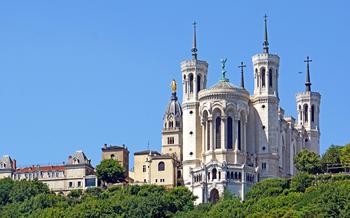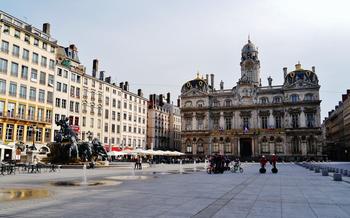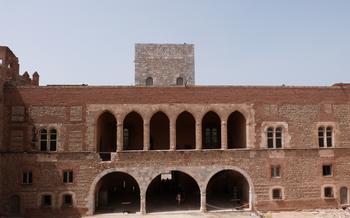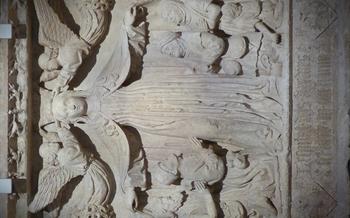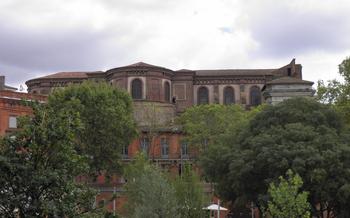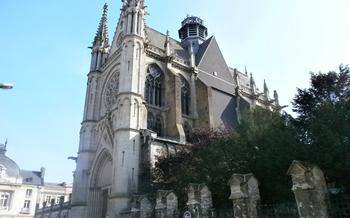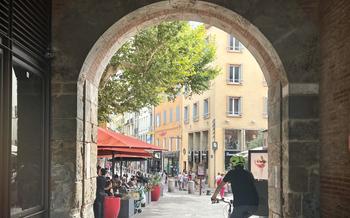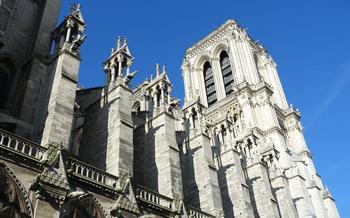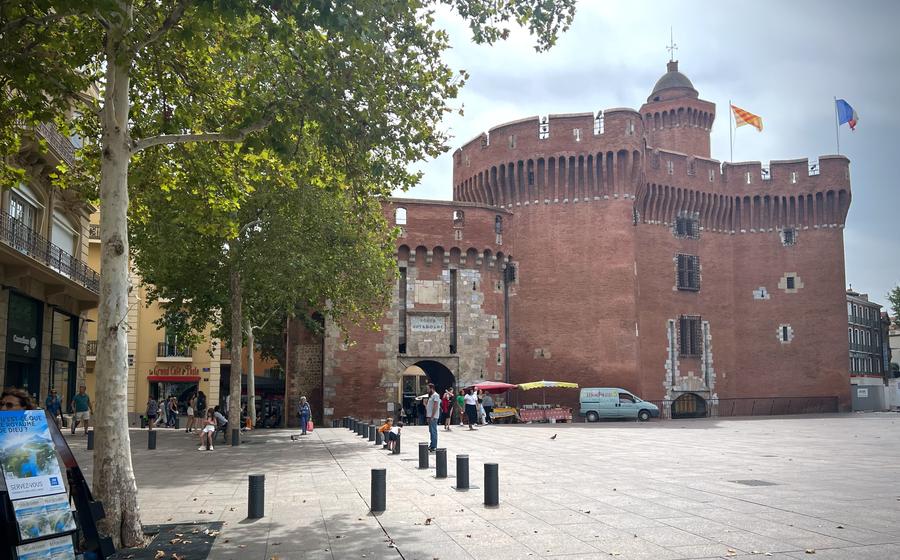
Couvent Sainte Marie de la Merci
- History of the Couvent Sainte Marie de la Merci
- Architecture of the Couvent Sainte Marie de la Merci
- The Church of the Couvent Sainte Marie de la Merci
- The Cloister of the Couvent Sainte Marie de la Merci
- The Museum of the Couvent Sainte Marie de la Merci
- The Gardens of the Couvent Sainte Marie de la Merci
- Visiting the Couvent Sainte Marie de la Merci
- Things to do near the Couvent Sainte Marie de la Merci
- Where to eat near the Couvent Sainte Marie de la Merci
- How to get to the Couvent Sainte Marie de la Merci
- The best time to visit the Couvent Sainte Marie de la Merci
- Tips for visiting the Couvent Sainte Marie de la Merci
- The history of the Merci order in Perpignan
- Insider Tip
History of the Couvent Sainte Marie de la Merci
The Couvent Sainte Marie de la Merci, also known as the Convent of Our Lady of Mercy, is a striking architectural masterpiece located in the heart of Perpignan, France. Its history dates back to the 13th century when the Merci order, a religious order dedicated to the redemption of Christian captives, arrived in Perpignan. In 1273, King Jaime I of Aragon granted the order a piece of land outside the city walls for the construction of a convent. The construction of the convent began in 1276 and was completed in 131
The Merci order played a significant role in the religious and social life of Perpignan. The order not only provided spiritual guidance to the city's inhabitants but also actively participated in the redemption of Christian captives held by the Saracens. The order's dedication to this cause earned them great respect and admiration from the local population.
In the 15th century, the convent underwent a significant expansion. King Ferdinand II of Aragon ordered the construction of a new wing to accommodate the growing number of friars. The new wing, known as the "Royal Wing," was completed in 149The convent's affiliation with the Spanish monarchy continued throughout the following centuries, and it served as a vital religious and cultural center for the city of Perpignan.
During the French Revolution, the convent was confiscated by the French government and converted into a military hospital. The friars were expelled, and the convent's treasures were looted. The convent suffered significant damage during this period, and many of its valuable artifacts were lost.
After the Napoleonic Wars, the convent was returned to the Merci order, and it underwent a period of restoration. In the 20th century, the convent was designated as a historical monument, and it has since been meticulously preserved. Today, the Couvent Sainte Marie de la Merci stands as a testament to the rich history and cultural heritage of Perpignan.
Architecture of the Couvent Sainte Marie de la Merci
The Couvent Sainte Marie de la Merci is a beautiful example of Gothic architecture. The church's exterior is characterized by its simple lines and pointed arches. The facade is decorated with a rose window and a Gothic portal. The interior of the church is equally impressive, with its high vaulted ceilings and stained glass windows. The cloister is a serene oasis, with its arcades and gardens.
The convent's architectural style is typical of the Gothic period in France. It is characterized by its pointed arches, ribbed vaults, and flying buttresses. The church's facade is particularly impressive, with its rose window and Gothic portal. The rose window is a large, circular window filled with stained glass. The Gothic portal is a large, arched doorway with intricate carvings.
The interior of the church is equally impressive. The nave is long and narrow, with high vaulted ceilings. The aisles are separated from the nave by pointed arches. The church is filled with stained glass windows, which depict scenes from the Bible and the lives of the saints. The main altarpiece is a large, carved wooden altarpiece that depicts the Virgin Mary and the Christ Child.
The cloister is a serene oasis in the midst of the city. It is surrounded by arcades and gardens. The arcades are supported by columns with pointed arches. The gardens are filled with flowers and trees. The cloister was used by the monks for prayer and meditation. It is now a popular tourist destination.
The Church of the Couvent Sainte Marie de la Merci
The Church of the Couvent Sainte Marie de la Merci is dedicated to Our Lady of Mercy, the patron saint of the Merci order. It was built in the 17th century and is a beautiful example of Baroque architecture. The interior of the church is richly decorated with paintings, sculptures, and gilding.
The main altarpiece is a masterpiece of Baroque art and depicts the Virgin Mary surrounded by angels. It was created by the famous sculptor Josep Sunyer in the 17th century. Other notable artworks in the church include the stained glass windows, the choir stalls, and the organ.
The church is a popular place of pilgrimage for Catholics from all over the world. It is also a popular tourist destination, and visitors are often impressed by its beauty and grandeur.
The Cloister of the Couvent Sainte Marie de la Merci
The cloister of the Couvent Sainte Marie de la Merci is one of the most beautiful and well-preserved examples of Gothic architecture in Perpignan. Built in the 14th century, the cloister is a serene and peaceful space, surrounded by elegant arches and delicate tracery. The centerpiece of the cloister is a fountain, which is surrounded by a garden of orange trees.
The cloister was originally used by the monks of the Merci order for meditation and prayer. It was also used as a place for teaching and study. Today, the cloister is open to the public and is a popular spot for visitors to relax and enjoy the tranquility of the convent.
The symbolism of the cloister's design is evident in its architecture. The four sides of the cloister represent the four cardinal directions, and the 12 arches represent the 12 months of the year. The fountain in the center of the cloister represents the source of life, and the orange trees represent purity and innocence.
In the past, the cloister was used by the monks for a variety of purposes, including meditation, prayer, study, and teaching. Today, the cloister is still used for religious purposes, but it is also open to the public and is a popular spot for visitors to relax and enjoy the tranquility of the convent.
The Museum of the Couvent Sainte Marie de la Merci
The Couvent Sainte Marie de la Merci also houses a museum that offers visitors a glimpse into the history of the convent and the Merci order. The museum is located in the former refectory of the convent and features a collection of artifacts, documents, and artwork related to the convent's past.
Among the highlights of the museum's collection are a 15th-century altarpiece depicting the Virgin Mary and Child, a collection of 17th-century religious manuscripts, and a series of paintings depicting the history of the Merci order. The museum also features a scale model of the convent and its grounds, as well as a touch screen display that provides visitors with additional information about the convent's history and architecture.
The museum is open to the public from Tuesday to Sunday, and admission is free of charge. Guided tours of the museum are available upon request. The museum is a valuable resource for anyone interested in learning more about the history of the Couvent Sainte Marie de la Merci and the Merci order.
The Gardens of the Couvent Sainte Marie de la Merci
The gardens of the Couvent Sainte Marie de la Merci are a hidden gem that most visitors miss. Located behind the convent, the gardens offer a peaceful oasis in the heart of the city. The gardens were created in the 17th century by the Merci order and were originally used to grow herbs and vegetables for the convent's kitchen. Today, the gardens are home to a variety of plants, including roses, lavender, and olive trees. The gardens are a popular spot for locals to relax and enjoy the outdoors.
The gardens are designed in a traditional French style, with geometric flower beds and gravel paths. The central feature of the garden is a large fountain, which is surrounded by a rose garden. The gardens also feature a number of statues, including one of the Virgin Mary. The gardens are a beautiful place to visit at any time of year, but they are especially stunning in the spring when the flowers are in bloom.
The gardens are open to the public during the day. Visitors are welcome to wander through the gardens and enjoy the peace and tranquility of this hidden oasis. The gardens are a great place to relax and reflect, or to simply enjoy the beauty of nature.
Visiting the Couvent Sainte Marie de la Merci
The Couvent Sainte Marie de la Merci is open to visitors from Tuesday to Sunday, with the exception of certain holidays. The hours of operation are typically from 10 am to 12 pm and from 2 pm to 5 pm. Visitors are recommended to check the convent's website for any changes in operating hours or closures.
Admission fees apply for adults, with discounts offered for students and seniors. Children under the age of 12 are admitted free of charge. Guided tours are available in French, English, and Spanish, and must be booked in advance. The tours provide an in-depth exploration of the convent's history, architecture, and religious significance.
The convent is wheelchair accessible, with ramps and elevators available for visitors with disabilities. Visitors can easily navigate the convent's grounds, including the church, cloister, and museum.
Whether you're a history buff, architecture enthusiast, or simply seeking a unique and spiritual experience, the Couvent Sainte Marie de la Merci is a must-visit destination in Perpignan. Its rich history, stunning architecture, and peaceful atmosphere make it a truly unforgettable place.
Things to do near the Couvent Sainte Marie de la Merci
After visiting the Couvent Sainte Marie de la Merci, there are many other things to see and do in Perpignan. History buffs can explore the city's other historical sites, such as the Palais des Rois de Majorque, the Cathédrale Saint-Jean-Baptiste, and the Musée d'Art Hyacinthe Rigaud. Art lovers can visit the city's museums and art galleries, such as the Musée des Beaux-Arts and the Musée Rigaud. Shoppers can browse the local markets, such as the Marché de la Place des Poilus and the Marché aux Puces de Perpignan. And foodies can try the local cuisine at one of the city's many restaurants, such as Le Grain de Sel and Le Catalan.
Where to eat near the Couvent Sainte Marie de la Merci
After a fascinating visit to the Couvent Sainte Marie de la Merci, you will surely have worked up an appetite. Luckily, there are plenty of excellent restaurants in the area where you can refuel and savor the delicious local cuisine.
For a truly authentic French dining experience, head to Le Comptoir des Halles, located just a short walk from the convent. This charming restaurant serves traditional French dishes made with fresh, seasonal ingredients. The menu changes daily, but you can always expect to find classics like coq au vin, escargots, and steak frites.
If you're looking for something a little more modern, try Le 5, a stylish restaurant with a creative menu that changes seasonally. The chef uses local and organic ingredients to create innovative dishes that are both delicious and visually appealing.
For a quick and casual bite, head to La Table du Marché, a small cafe that serves up delicious sandwiches, salads, and pastries. This is a great option if you're on a budget or if you're just looking for a light snack.
No matter what your taste or budget, you're sure to find something to your liking in the restaurants near the Couvent Sainte Marie de la Merci.
How to get to the Couvent Sainte Marie de la Merci
The Couvent Sainte Marie de la Merci is located in the historic center of Perpignan, making it easily accessible by foot or by public transportation. The closest bus stop is "Couvent Sainte Marie de la Merci," which is served by several bus lines, including lines 1, 2, and For those arriving by car, there are several parking options available near the convent.
The most convenient parking option is the underground parking lot located at the Place de la République, which is just a short walk from the convent. Alternatively, there are several on-street parking spaces available in the surrounding streets. However, it is important to note that parking in the city center can be limited, so it is advisable to arrive early or use public transportation.
The convent is also accessible by train, as the Perpignan train station is located just a 15-minute walk away. From the train station, visitors can either walk or take a short bus ride to the convent.
The best time to visit the Couvent Sainte Marie de la Merci
Perpignan experiences a Mediterranean climate with hot, dry summers and mild, wet winters. The best time to visit the Couvent Sainte Marie de la Merci is during the shoulder seasons, spring (April-May) and autumn (September-October), when the weather is pleasant and there are fewer tourists.
During the summer months (June-August), temperatures can soar above 30 degrees Celsius, making it uncomfortable to explore the convent's outdoor areas. The winter months (November-March) can be chilly, with occasional rain and strong winds.
The convent hosts several special events throughout the year, including concerts, exhibitions, and religious ceremonies. It is worth checking the convent's website or contacting them directly to find out about upcoming events.
To avoid the crowds, it is advisable to visit the convent during the weekdays, as it tends to be quieter than on weekends. If you are interested in taking photos of the convent, the best time to do so is early in the morning or late in the afternoon, when the light is softer and more flattering.
Tips for visiting the Couvent Sainte Marie de la Merci
When visiting the Couvent Sainte Marie de la Merci, it is important to be respectful of the religious nature of the site. Visitors should dress appropriately and avoid making noise or taking photos during religious services. It is also important to be aware of the safety precautions that are in place, such as the no-smoking policy and the requirement to wear sturdy shoes on the uneven cobblestones.
Here are some additional tips for visiting the convent:
- Dress code: Visitors should dress modestly and avoid wearing shorts, tank tops, or revealing clothing.
- Photography: Photography is allowed in most areas of the convent, but flash photography is not permitted.
- Safety precautions: Visitors should be aware of the uneven cobblestones and steps, and should wear sturdy shoes. The convent is not accessible to visitors with disabilities.
- Respect: Visitors should be respectful of the religious nature of the convent and avoid making noise or taking photos during religious services.
By following these tips, visitors can help to ensure that the Couvent Sainte Marie de la Merci remains a peaceful and welcoming place for all.
The history of the Merci order in Perpignan
The Merci order arrived in Perpignan in the early 13th century, at a time when the city was a thriving center of trade and culture. The order quickly established itself as a major religious and social force in the city, and the construction of the Couvent Sainte Marie de la Merci began soon after. The convent became the headquarters of the order in Perpignan, and it played a significant role in the city's religious and social life for centuries.
The Merci order was dedicated to the redemption of Christian captives who had been taken by Muslim pirates. The order's work was particularly important in Perpignan, which was a major port city and a frequent target of pirate raids. The Merci order worked to ransom Christian captives and to provide them with food, shelter, and medical care. The order also worked to convert Muslim captives to Christianity.
The Merci order was a major force for good in Perpignan, and its work helped to improve the lives of many people. The order's legacy in the city is still visible today, in the form of the Couvent Sainte Marie de la Merci and the many other religious and social institutions that it founded.
Insider Tip
A Hidden Gem in the Convent that Most Visitors Miss:
In a secluded corner of the convent, nestled amidst lush greenery and blooming flowers, lies a hidden gem that often goes unnoticed by visitors: a serene and intimate garden known as the "Jardin des Simples." This enchanting space, tucked away from the hustle and bustle of the main courtyard, offers a tranquil oasis for reflection and contemplation. As you step into the Jardin des Simples, you are greeted by a symphony of colors and fragrances, with aromatic herbs, vibrant flowers, and medicinal plants adorning every corner. Take a moment to pause and appreciate the beauty of nature as you wander through the garden's winding paths, discovering hidden nooks and secret corners.
A Unique Experience that Can Be Had at the Convent:
For those seeking a truly immersive experience, the Couvent Sainte Marie de la Merci offers a unique opportunity to stay overnight within the convent's hallowed walls. As a guest of the convent, you will be granted exclusive access to the cloister, the gardens, and the church after hours, allowing you to experience the tranquility and spirituality of the convent in a way that is not possible during regular visiting hours. Imagine waking up to the sound of Gregorian chants echoing through the cloisters, or enjoying a meditative walk through the gardens as the sun casts its golden glow upon the ancient stones.
A Little-Known Fact about the Convent:
One of the most fascinating yet lesser-known facts about the Couvent Sainte Marie de la Merci is its connection to the world of espionage. During the Second World War, the convent served as a secret meeting place for French Resistance fighters and Allied spies. Hidden beneath the convent's seemingly innocuous facade, brave men and women plotted and strategized, risking their lives to undermine the Nazi occupation. The convent's cloisters and secret passages provided a safe haven for these courageous individuals, allowing them to plan their missions and exchange vital information without fear of detection.
A Personal Anecdote about the Convent:
I have a personal connection to the Couvent Sainte Marie de la Merci that makes it particularly special to me. Several years ago, I had the privilege of attending a classical music concert held in the convent's church. The acoustics were simply breathtaking, and the music seemed to resonate through the very walls of the building, creating a truly magical atmosphere. As I sat there listening to the hauntingly beautiful melodies, I couldn't help but feel a sense of awe and wonder at the rich history and spiritual significance of this extraordinary place.
